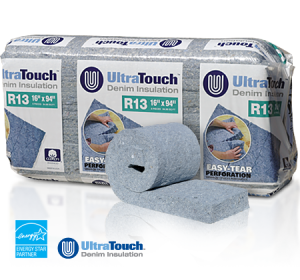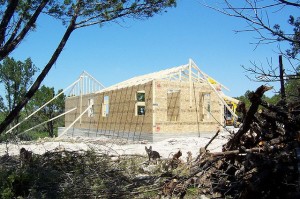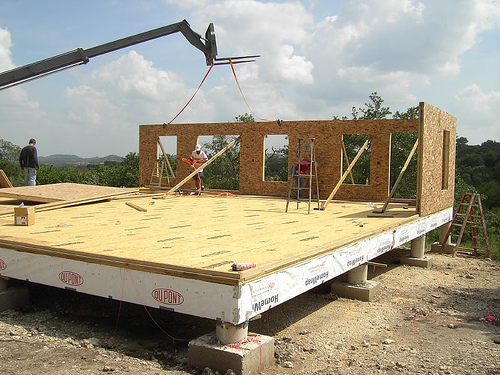There are many “shades of green” – you have to decide what your priorities are, everyone is different.
Use Non-Toxic Building Materials: You can find healthier products for you and your family. Products that are healthier for us are also better for the environment. You can find these products online and specialty shops, search “non-toxic building materials”.
Did you know you can buy insulation made from leftover blue-jean material (Denim)?

or buy prefabricated walls made of compressed wheat straw?


Below is basic list just to get a quick idea of better products available:
Building and RemodelingPaints, Finishes, Sealants
Adhesives, Grouts, Thinsets, Caulks
Flooring
Roofing
Cements, Clays, Plasters
Alternative Wood Products
Alternative Building Systems
Insulation, Ductwork Around The House
Air Filters
Water Filters, Air Filters
Cleaning
Insect Control
Lighting
Organic Bedding
Shower Curtains
Wall, Window Coverings
Smaller is Better: A small home built with eco friendly techniques is going to have smaller environmental impact as against a large home. A house that is too large is likely to cost more to heat and cool. Try to keep the place manageable and cost effective. If you are planning to extend your family and bring in few relatives, you need to put proper resources and accommodation in place.
Energy Efficient Equipment: ENERGY STAR label on a piece of equipment states that particular product has been deemed as energy efficient by the Environmental Protection Agency(EPA). ENERGY STAR is becoming well known label and consumers today choose energy star appliances for their homes. These appliances offer significant cost and energy savings without compromising performance.
Proper Insulation: Insulation is one of the most important ting that you need to consider while building a green home. Heating and cooling account for 50% of your home’s energy consumption. Air leaks such as around windows, door and duct work is responsible for building’s heat loss. Don’t let heating and cooling of your interior spaces air go waste through improper insulation. Proper insulation will not only reduce your energy consumption but will bring down your electricity bills substantially.
Reduce, Reuse, Recycle: Reduce your need for buying new products that are not environment friendly. Reuse your old material such as wood floors, doors, windows in your next home. Recycled materials such as recycled glass, aluminium, recycled tile, reclaimed lumber, recycled plastic can be used in green home building.
Use Sustainable Building Materials: If building a green home is your goal, then using environmentally or eco-friendly products should be on your list which can reduce the impact of construction on the environment. Each and every part of your house such as roofing material, building material, cabinets, counters and insulation to your flooring should be environmentally friendly. Use products such as reclaimed lumber, recycled plastic, recycled glass or natural products such as bamboo, cork and linoleum which are made of natural, renewable materials.
Solar Panels: Solar energy is clean and renewable source of energy. Solar panels are an emerging and hot technology for people who want to utilize the natural power all around us, the sun. Solar panels may be expensive at first, but the long-term savings you can put into your pocket is a stunning example of the benefits of turning your life from black to green. The location of your house and the way you have constructed solar panels can determine how much power you can collect. By taking advantage of solar power you can bring down your energy consumption and supply excess energy, if any, to your utility company. Also, government grants, incentives and tax breaks are huge bonus to those who want to use solar power in their home.
Energy Star Windows: Energy efficient windows labeled as ENERGY STAR windows are new player in window market and are much more energy efficient than normal windows. The ratings for these windows determine how energy efficient they will be. The lower the rating, the more energy efficient are your windows. The energy savings provided by these windows are enough to cover the added cost per window.
Rainwater Harvesting Systems and Tankless Water Heaters: Install a rainwater harvesting system while building your green home to collect rainwater from roofs and then storing it in a tank. The collected water can then be used for other purposes such as toilets and sprinkler systems. Rain barrels are one of the most common methods of rainwater harvesting being used today.
With tankless water heaters, you need not wait for the water to get heated. Tankless water heaters heat only that much water that is needed as it is passed through electric coil. This gives you twin benefits. Firstly, it eliminates excess energy costs as it heats up only that much amount of water that is needed and secondly, you can get ample storage place by eliminating the hot water tank.
Eco-Friendly Lighting: LED’s use less energy and last longer than traditional incandescent bulbs. Since they offer significant cost savings in the long run, they can be ideal for your new green home.
Water Conserving Fixtures: Low flow faucets, toilets, showerheads are few of the ways that you can use while building a green home to conserve water. They can cut down on your water bills cost and make your home much more environment friendly. Apart from that, consider buying washing machines and dishwashers that give you same kind of cleaning and can save water and energy.
Programmable Thermostat: We all know that almost 50% of our energy consumption goes towards heating and cooling of our home. The simplest way to cut down this cost and reduce electricity bill is to install programmable thermostat. Your HVAC system will work when the thermostat reaches the designated temperature. Also, a slight 3-5 % of your energy bill can be saved if you can set your thermostat 1 degree down in the winter and up by 1 degree in the summer.
HVAC System: Buy a high efficiency, Energy Star rated HVAC system based on the design and construction of your house that will help you save energy and money. A HVAC system needs to be properly installed so that it could perform up to its full potential. Make sure ducts are short, straight and air tight. The ducts need to be professionally tested with the goal of under 10% leakage.
Efficient Landscaping: Shady landscaping can protect your home from direct sunlight during the summer and allows more sunlight to reach your home through windows during the winter. Planting trees on southern and western side of your home can keep your home cooler as they will block sunlight from falling directly on your home and during the winter, when trees lose their leaves, they will allow more sunlight to reach your home.
Harness Geothermal Energy: Geothermal energy is known as energy from the earth. Geothermal energy requires more upfront investment but provide unlimited energy to heat and cool your home. During the winter season, geothermal heat pump uses the earth loop to extract heat from deep underground to your home’s HVAC system; in the summer season, heat is extracted from the air and moved back into the earth through loop system.
SourcesAgriboard Bondedlogic Environmental Depot Conserve-energy-future.com

